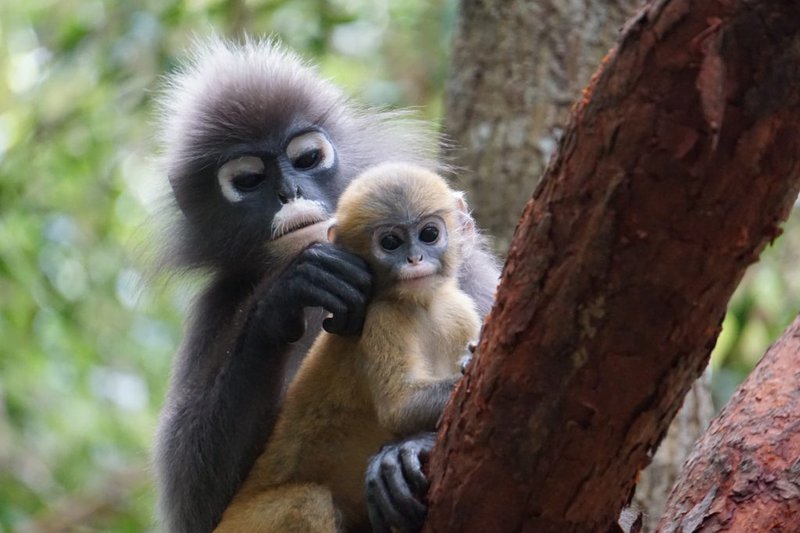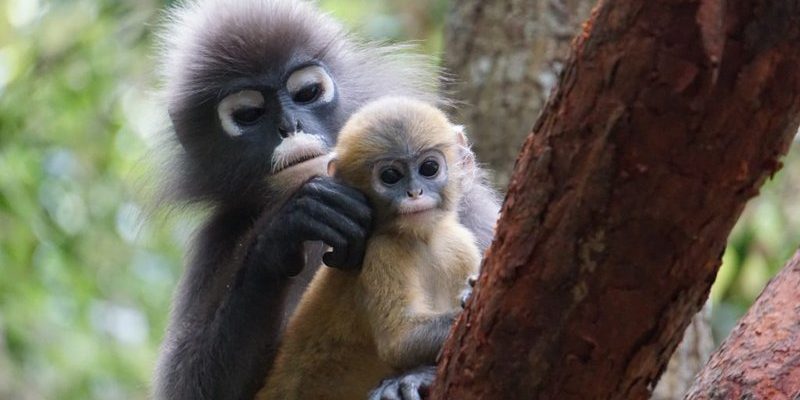
Imagine living in a place where food and water are not always readily available. You’d have to be resourceful, right? Well, that’s exactly what langurs do. They rely on their intelligence, social behaviors, and physical adaptations to navigate and survive in harsh conditions. Whether it’s finding food or protecting themselves from predators, these agile animals exhibit a remarkable ability to cope with their environments. Let’s dive deeper into how langurs manage to thrive where others might falter.
Physical Adaptations for Survival
One of the first things you’ll notice about langurs is their bodies, which are uniquely designed for climbing and jumping through trees. Their long limbs and strong muscles allow them to leap from branch to branch, covering great distances in search of food. This agility is crucial, especially in dense forests where competition for resources can be fierce.
Langurs also have specialized hands and feet. Their fingers are long and nimble, making it easy to grasp onto branches and pick fruits. This ability to forage high in the trees gives them an edge over many ground-dwelling animals. You might even see them hanging upside down to reach leaves that are otherwise out of reach!
Furthermore, langurs have thick fur that not only keeps them warm in cooler climates but also protects their skin from the harsh sun in tropical areas. The coloration of their fur can also provide camouflage among the leaves, helping them avoid detection by predators. Isn’t it fascinating how nature equips animals with just the right tools for survival?
Dietary Flexibility
Langurs are primarily herbivorous, meaning they eat a lot of greens. But here’s the thing: they’re not picky eaters. Their diet consists of a wide variety of plants, fruits, leaves, and flowers. This flexibility allows them to thrive even when certain food sources are scarce.
During periods of drought or in harsh environments, langurs can switch their diet to include tougher foliage that other animals might ignore. They have a unique digestive system that helps them break down fibrous plant material, allowing them to extract the maximum amount of nutrients from their food. Imagine being able to eat something that would make most animals turn their noses up!
Moreover, langurs often get together in groups to forage. This social behavior not only helps them find food more efficiently but also provides safety in numbers. You might find them grooming each other, which strengthens social bonds and is another way they manage to survive in tough environments.
Social Structure and Communication
Social dynamics among langurs are fascinating! They live in groups, known as troops, which can range from a few individuals to 30 members. This troop structure is vital for their survival, especially in harsh environments where cooperation becomes essential.
Langurs communicate using a variety of vocalizations, facial expressions, and body language. This complex communication system helps them alert each other to dangers like predators or changes in the environment. Imagine being able to signal your friends from across the forest when there’s trouble brewing!
In these groups, there’s often a clear hierarchy, with dominant males usually claiming breeding rights. However, females play a crucial role in nurturing young and maintaining social bonds. This strong sense of community not only ensures the survival of individuals but also the continuation of their species.
Water Conservation Techniques
In many harsh environments, finding water can be a significant challenge. However, langurs have developed several techniques to survive even during dry seasons. One of the best adaptations is their ability to extract moisture from the food they eat. By consuming leaves and fruits that contain a high water content, they can minimize their need for direct water sources.
Additionally, langurs are known to alter their activity patterns. During the hottest parts of the day, they often rest in the shade of trees, conserving energy and reducing water loss through sweat. You might see them lounging around, grooming each other or just napping, which is as crucial to their survival as foraging for food.
Also, when water is available, they often drink in moderation. This strategy helps to ensure that they don’t become overly dependent on a single source, which might dry up or become contaminated.
Adapting to Climate Challenges
Langurs have a remarkable ability to thrive in diverse climates, from the tropical forests of India to the rugged mountains of Nepal. Each species has adapted to its specific environment, developing behaviors that ensure their survival. For instance, langurs living in colder areas tend to have thicker fur and may migrate to lower elevations during severe winters.
In more variable climates, these monkeys often display behavior patterns that allow them to quickly adapt to changes. If there’s a sudden change in weather, they’ll adjust their feeding habits or seek shelter in trees to avoid extreme temperatures. It’s like having a built-in survival guide!
Their adaptability is also visible in how they interact with their environment. Langurs often alter their foraging strategies based on food availability, showcasing their intelligent problem-solving skills. So, whether they’re dodging rainstorms or finding the best fruit trees, langurs prove time and again that they can face just about anything nature throws at them.
Predator Awareness and Defense Mechanisms
Predators are an ever-present threat, especially in the wild. Langurs have developed a keen sense of awareness that keeps them safe. They often perch high in the trees, giving them a vantage point to spot potential dangers. When they do see a predator, like a leopard or a large bird of prey, they emit loud alarm calls to warn the rest of the troop.
Alongside their vocal warnings, langurs often use groups to fend off threats. By banding together, they create confusion and make it harder for predators to target any one individual. This teamwork not only protects them but also strengthens their social bonds.
In the event of an attack, langurs are quick and agile. They can escape into the trees, using their climbing skills to reach safety swiftly. This dance between predator and prey is a constant in their lives, showcasing the balance of nature and the skills langurs have honed to survive.
The Importance of Conservation
Despite their impressive adaptations, langurs face numerous threats, including habitat loss and poaching. Urban expansion and agricultural practices lead to deforestation, which directly impacts their survival. Understanding how langurs adapt is vital for conservation efforts aimed at protecting these incredible primates.
Conservation programs are now more crucial than ever. They focus on habitat preservation, anti-poaching initiatives, and raising awareness about the importance of these animals in maintaining ecological balance. Educating local communities about the benefits of preserving langurs can create a supportive environment for these creatures.
By promoting sustainable practices and protecting their habitats, we can help ensure that langurs will continue to thrive in harsh environments for generations to come. It’s a team effort—just like the way langurs work together in their troops!
As you can see, langurs are truly remarkable creatures, showcasing incredible survival skills in the face of adversity. Their unique adaptations, social structures, and clever strategies prove that they are more than capable of thriving in some of the world’s toughest environments. Understanding their world not only helps us appreciate these primates but also emphasizes the urgency of conservation efforts to secure their future.

